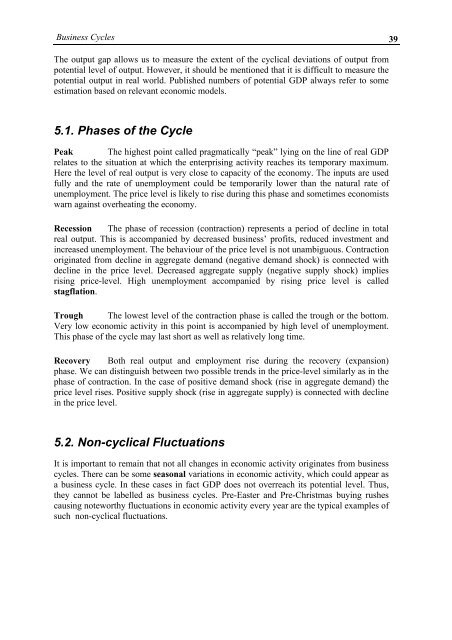MacroeconomicsI_working_version (1)
You also want an ePaper? Increase the reach of your titles
YUMPU automatically turns print PDFs into web optimized ePapers that Google loves.
Business Cycles 39<br />
The output gap allows us to measure the extent of the cyclical deviations of output from<br />
potential level of output. However, it should be mentioned that it is difficult to measure the<br />
potential output in real world. Published numbers of potential GDP always refer to some<br />
estimation based on relevant economic models.<br />
5.1. Phases of the Cycle<br />
Peak The highest point called pragmatically “peak” lying on the line of real GDP<br />
relates to the situation at which the enterprising activity reaches its temporary maximum.<br />
Here the level of real output is very close to capacity of the economy. The inputs are used<br />
fully and the rate of unemployment could be temporarily lower than the natural rate of<br />
unemployment. The price level is likely to rise during this phase and sometimes economists<br />
warn against overheating the economy.<br />
Recession The phase of recession (contraction) represents a period of decline in total<br />
real output. This is accompanied by decreased business’ profits, reduced investment and<br />
increased unemployment. The behaviour of the price level is not unambiguous. Contraction<br />
originated from decline in aggregate demand (negative demand shock) is connected with<br />
decline in the price level. Decreased aggregate supply (negative supply shock) implies<br />
rising price-level. High unemployment accompanied by rising price level is called<br />
stagflation.<br />
Trough The lowest level of the contraction phase is called the trough or the bottom.<br />
Very low economic activity in this point is accompanied by high level of unemployment.<br />
This phase of the cycle may last short as well as relatively long time.<br />
Recovery Both real output and employment rise during the recovery (expansion)<br />
phase. We can distinguish between two possible trends in the price-level similarly as in the<br />
phase of contraction. In the case of positive demand shock (rise in aggregate demand) the<br />
price level rises. Positive supply shock (rise in aggregate supply) is connected with decline<br />
in the price level.<br />
5.2. Non-cyclical Fluctuations<br />
It is important to remain that not all changes in economic activity originates from business<br />
cycles. There can be some seasonal variations in economic activity, which could appear as<br />
a business cycle. In these cases in fact GDP does not overreach its potential level. Thus,<br />
they cannot be labelled as business cycles. Pre-Easter and Pre-Christmas buying rushes<br />
causing noteworthy fluctuations in economic activity every year are the typical examples of<br />
such non-cyclical fluctuations.




